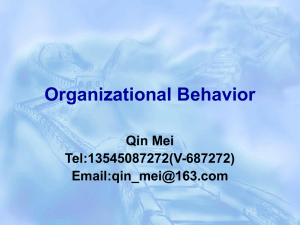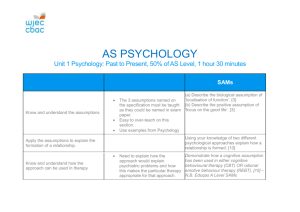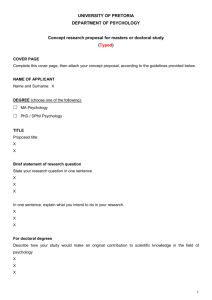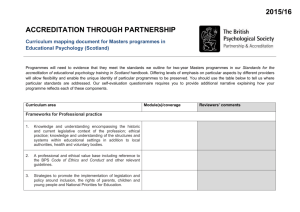THE FIELD OF ORGANIZATIONAL BEHAVIOR c~J
advertisement
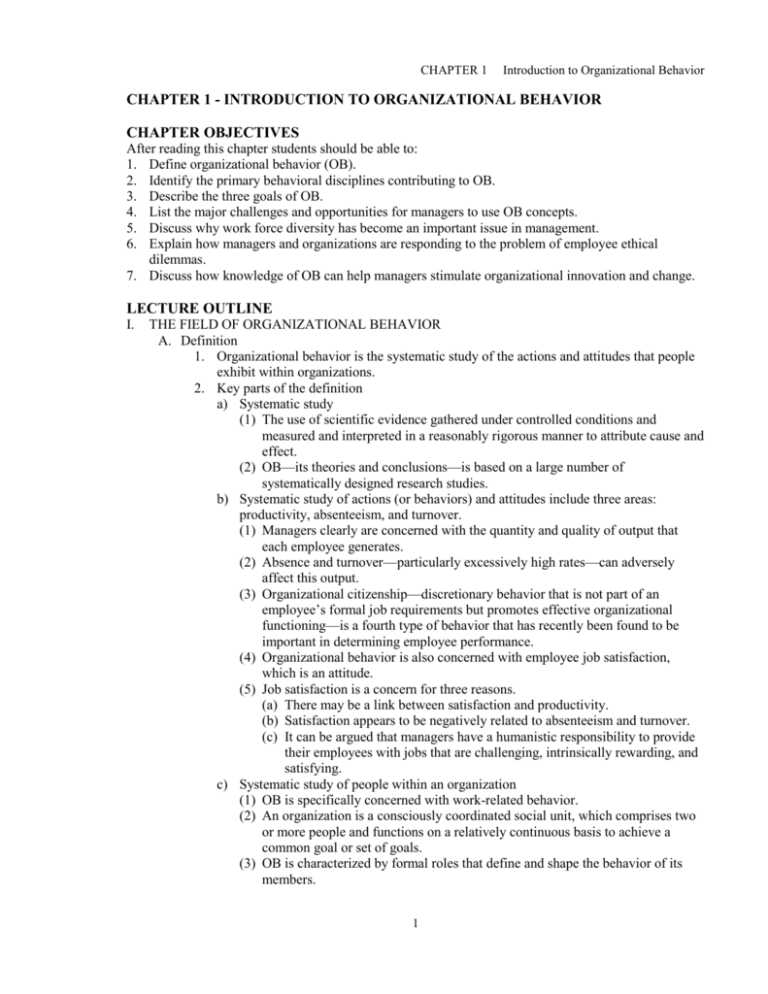
CHAPTER 1 Introduction to Organizational Behavior CHAPTER 1 - INTRODUCTION TO ORGANIZATIONAL BEHAVIOR CHAPTER OBJECTIVES After reading this chapter students should be able to: 1. Define organizational behavior (OB). 2. Identify the primary behavioral disciplines contributing to OB. 3. Describe the three goals of OB. 4. List the major challenges and opportunities for managers to use OB concepts. 5. Discuss why work force diversity has become an important issue in management. 6. Explain how managers and organizations are responding to the problem of employee ethical dilemmas. 7. Discuss how knowledge of OB can help managers stimulate organizational innovation and change. LECTURE OUTLINE I. THE FIELD OF ORGANIZATIONAL BEHAVIOR A. Definition 1. Organizational behavior is the systematic study of the actions and attitudes that people exhibit within organizations. 2. Key parts of the definition a) Systematic study (1) The use of scientific evidence gathered under controlled conditions and measured and interpreted in a reasonably rigorous manner to attribute cause and effect. (2) OB—its theories and conclusions—is based on a large number of systematically designed research studies. b) Systematic study of actions (or behaviors) and attitudes include three areas: productivity, absenteeism, and turnover. (1) Managers clearly are concerned with the quantity and quality of output that each employee generates. (2) Absence and turnover—particularly excessively high rates—can adversely affect this output. (3) Organizational citizenship—discretionary behavior that is not part of an employee’s formal job requirements but promotes effective organizational functioning—is a fourth type of behavior that has recently been found to be important in determining employee performance. (4) Organizational behavior is also concerned with employee job satisfaction, which is an attitude. (5) Job satisfaction is a concern for three reasons. (a) There may be a link between satisfaction and productivity. (b) Satisfaction appears to be negatively related to absenteeism and turnover. (c) It can be argued that managers have a humanistic responsibility to provide their employees with jobs that are challenging, intrinsically rewarding, and satisfying. c) Systematic study of people within an organization (1) OB is specifically concerned with work-related behavior. (2) An organization is a consciously coordinated social unit, which comprises two or more people and functions on a relatively continuous basis to achieve a common goal or set of goals. (3) OB is characterized by formal roles that define and shape the behavior of its members. 1 Part I Prologue B. Contributing Disciplines 1. Organizational behavior is applied behavioral science. a) The predominant contributing disciplines are psychology, sociology, social psychology, anthropology, and political science. b) Psychology contributes mainly at the individual/micro level of analysis, whereas the latter disciplines contribute on the group/macro level of analysis. 2. Psychology is the science that seeks to measure, explain, and sometimes change the behavior of humans and other animals. a) Psychologists concern themselves with studying and attempting to understand individual behavior. b) Contributors are learning theorists, personality theorists, counseling psychologists, and, most important, industrial and organizational psychologists. c) Early industrial psychologists concerned themselves with problems of fatigue, boredom, and any other factor relevant to working conditions that could impede efficient work performance. d) More recently, their contributions have been expanded to include learning, perception, personality, emotions, training, leadership effectiveness, needs and motivational forces, job satisfaction, decision-making processes, performance appraisals, attitude measurement, employee-selection techniques, job design, and work stress. 3. Sociology studies people in relation to their fellow human beings. a) Greatest contribution has resulted from their study of group behavior in organizations, particularly formal and complex organizations. b) Areas of valuable input include group dynamics, design of work teams, organizational culture, formal organization theory and structure, bureaucracy, communications, status, power, conflict, and work/life balance. 4. Social psychology is an area within psychology, blending concepts from psychology and sociology. a) It focuses on the influence of people on one another. b) A major area of concern—change—how to implement it and how to reduce barriers to its acceptance. c) Areas of significant contributions are in measuring, understanding, and changing attitudes, communication patterns, the ways in which group activities can satisfy individual needs, and group decision-making processes. 5. Anthropology is the study of societies to learn about human beings and their activities. a) It includes human physical character, evolutionary history, geographic distribution, group relationships, and cultural history and practices. b) This has helped us understand differences in fundamental values, attitudes, and behavior between people in different countries and within organizations. 6. Political science, the study of the behavior of individuals and groups within a political environment, is frequently overlooked. a) Specific topics of concern to political scientists include structuring of conflict, allocation of power, and how people manipulate power for individual self-interest. II. GOALS OF ORGANIZATIONAL BEHAVIOR A. What three goals does OB seek? B. Explanation 1. Seek to answer why an individual or a group of individuals did something. 2 CHAPTER 1 Introduction to Organizational Behavior 2. Explanation is the least important of the three goals, from a management perspective, because it occurs after the fact. C. Prediction 1. The goal of prediction focuses on future events to determine what outcomes will result from a given action. 2. There are various ways to implement a major change, so the manager is likely to assess employee responses to several change interventions. Such information can be used in making the decision as to which change effort to use. D. Control 1. The most controversial goal is to control behavior because most of us live in democratic societies, which are built upon the concept of personal freedom. 2. OB does offer technologies that facilitate the control of people. a) Whether those technologies should be used in organizations becomes an ethical question. III. CHALLENGES AND OPPORTUNITIES FOR OB: A MANAGERIAL PERSPECTIVE A. The ability to explain, predict, and control organizational behavior has never been more important to managers because of changing workforce demographics; global competition which require flexibility, rapid change and innovation; and organizational commitment and loyalty changes. B. Improving Quality and Productivity 1. Peter Wood manages in a very competitive business. He is the manufacturing-systems manager at the Oak Creek, Wisconsin, plant for Delphi Automotive Systems, which makes catalytic converters for more than forty automobile manufacturers. a) By using teamwork cells, empowering employees with total responsibility for quality, hundreds of wasteful processes were cut from the production system. Within two years, productivity has increased by more than 25 percent, quality has improved, and delivery time has been cut from three weeks to four days. 2. Managers are confronting the challenges that Peter Wood is facing. To improve quality and productivity, they are implementing programs such as quality management and process reengineering, which require extensive employee involvement. a) See Exhibit 1-2, What Is Total Quality Management? 3. Reengineering asks managers to reconsider how work would be done and how would their organization be structured if they were to start over? C. Improving People Skills 1. People skills are critical to managerial effectiveness. 2. There are specific people skills that managers can use on the job. a) The text will raise this as you read. D. Managing Workforce Diversity 1. A key challenge currently facing all organizations—domestic and international. 2. Workforce diversity means that organizations are becoming more heterogeneous in terms of gender, race, and ethnicity. a) Encompasses anyone who varies from the norm. In addition to the more obvious groups—women, African Americans, Hispanic Americans, and Asian Americans— it also includes the physically disabled, homosexuals, and the elderly. 3. Traditional melting pot approach to differences in organizations assumed that people who were different would somehow automatically want to assimilate. 3 Part I Prologue 4. Now the challenge for organizations is to make themselves more accommodating to diverse groups. 5. Diverse groups were such a small percentage of the U.S. workforce. a) The bulk of the pre-1980s workforce was male Caucasians working full time to support a nonemployed wife and school-aged children. b) Currently, 46 percent of the U.S. labor force are women. Minorities and immigrants make up 23 percent. 6. Workforce diversity has important implications for management practice. a) Managers need to recognize differences and respond to them. (1) Diversity, if positively managed, can increase creativity and innovation in organizations as well as improve decision making by providing different perspectives on problems. E. Responding to Globalization 1. Management is no longer constrained by national borders. a) Four of the five highest grossing McDonald’s restaurants are in Hong Kong. b) Prentice Hall, the largest seller of college textbooks in the United States and the publisher of this book, is owned by a British company. c) Exxon/Mobil receives almost 75 percent of its revenues from sales outside the United States. 2. Globalization affects a manager’s people skills in at least two ways. a) If you are a manager, you are increasingly likely to find yourself in a foreign assignment. b) Even in your own country, you are going to find yourself working with bosses, peers, and subordinates who were born and raised in different cultures. F. Empowering People 1. The reshaping of the relationship between managers and those they are supposedly responsible for managing. a) Decision-making is being pushed down to the operating level. b) Managers are allowing employees full control of their work. c) An increasing number of organizations are using self-managed teams. 2. Managers are empowering employees. 3. Managers are having to learn how to give up control, and employees are having to learn how to take responsibility for their work and make appropriate decisions. G. Stimulating Innovation and Change 1. Today’s successful organizations must foster innovation and master the art of change or they will become candidates for extinction. 2. Victory will go to those organizations that maintain their flexibility, continually improve their quality, and beat their competition to the marketplace with a constant stream of innovative products and services. 3. The challenge for managers is to stimulate employee creativity and tolerance for change. a) The field of OB provides a wealth of ideas and techniques to aid in realizing these goals. H. Coping with “Temporariness” 1. Managers have always been concerned with change. What is different is the amount of time between change implementations. 4 CHAPTER 1 Introduction to Organizational Behavior 2. Today, change is an ongoing activity for most managers. The concept of continuous improvement, for instance, implies constant change. 3. Managing used to be characterized by long periods of stability interrupted occasionally by short periods of change. a) That is reversed today. 4. Managers and employees face a world of permanent “temporariness.” a) Workers need to continually update their knowledge and skills to perform new job requirements. b) Work groups are also increasingly in a state of flux. In the past employees were assigned to a specific department, and that assignment was relatively permanent. c) Organizations themselves are in a state of flux. They continually reorganize their various divisions, sell off poorly performing businesses, downsize operations, and replace permanent employees with temporaries. 5. Today’s managers and employees must learn to learn to live with flexibility, spontaneity, and unpredictability. I. Helping Employees Balance Work/Life Conflicts 1. The typical employee no longer shows up Monday through Friday for an eight- or ninehour shift. 2. A number of forces have contributed to the blurring of the line between work and nonwork time, thus, creating personal conflicts and stress. a) The creation of global organizations means the work world never sleeps. b) Communication technology allows employees to do their work anywhere—at home, in their car, or on the beach. c) Organizations are asking employees to put in longer hours. d) Few families have only a single breadwinner. 3. Employees are not happy about work squeezing out personal lives. 4. Organizations that do not help their people achieve work/life balance will find it increasingly hard to attach and retain employees. J. Declining Employee Loyalty 1. Corporate employees used to believe that their employers would reward loyalty and good work with job security, generous benefits, and steady pay increases. 2. That changed beginning in the mid-1980s as corporations sought to become “lean and mean” by closing factories, moving operations to lower-cost countries, selling off or closing down less-profitable businesses, eliminating entire levels of management, replacing permanent employees with temporaries, and substituting performance-based pay systems for seniority-based programs. 3. European companies are also doing this. 4. These changes have resulted in a sharp decline in employee loyalty. K. Improving Ethical Behavior 1. In today’s organizational world it is not surprising that many employees feel pressured to cut corners, break rules, and engage in other forms of questionable practices. 2. Members of organizations are increasingly finding themselves facing ethical dilemmas, situations in which they are required to define right and wrong conduct. 3. Good ethical behavior has never been clearly defined. a) In recent years the line differentiating right from wrong has become even more blurred. b) All around them employees see people—elected officials, successful executives, and employees in other companies—engaging in unethical practices. 5 Part I Prologue 4. There are a variety of responses to this problem. a) Write and distribute codes of ethics to guide employees through ethical dilemmas. b) Offer seminars, workshops, and similar training programs to try to improve ethical behaviors. c) Provide in-house advisors, who can be contacted, in many cases anonymously, for assistance in dealing with ethical issues. d) Create protection mechanisms for employees who reveal internal unethical practices. 5. Today’s manager needs to create an ethically healthful climate in which his or her employees can do their work productively and confront a minimal degree of ambiguity regarding what constitutes right and wrong behaviors. IV. THE PLAN OF THIS BOOK A. The book uses a building block approach. 1. See Exhibit 1-3. 2. Chapters 2 through 6 deal with the individual in the organization. a) The foundations of individual behavior—values, attitudes, perception, and learning. b) The role of personality and emotions in individual behavior. c) Conclude with motivation issues and individual decision making. 3. Chapters 7 through 12 address group behavior. a) Introduce a group behavior model. b) Discuss ways to make teams more effective. c) Consider communication issues and group decision-making. d) Investigate leadership and the issues of trust, power, politics, and conflict and negotiation. 4. Organizational behavior reaches its highest level of sophistication when we add the formal organization system to our knowledge of individual and group behavior. Chapters 13 through 17, discuss: a) How an organization’s structure, work design, and technology affect behavior. b) The effect that an organization’s human resource policies and practices have on people. c) How each organization has its own culture that acts to shape the behavior of its members. d) The various organizational change and development techniques that managers can use to affect behavior for the organization’s benefit. SUMMARY 1. Organizational behavior (OB) is the systematic study of the actions and attitudes that people exhibit within organizations. 2. Organizational behavior is applied behavioral science. The predominant contributing disciplines are psychology, sociology, social psychology, anthropology, and political science. 3. The three primary goals of OB are to explain why an individual or a group of individuals do something; to predict future events—to determine what outcomes will result from a given action; and to control behavior, the most controversial goal of the three. OB does offer technologies that facilitate the control of people. Whether those technologies should be used in organizations becomes an ethical question. 4. The major challenges and opportunities for managers to use OB concepts occur in the areas of improving quality and productivity through the use of quality management, reengineering and other techniques; improving people skills; managing workforce diversity—a key challenge since organizations are becoming more heterogeneous in terms of gender, race, and ethnicity; responding to globalization; empowering people by the reshaping of the relationship between managers and 6 CHAPTER 1 Introduction to Organizational Behavior those they’re supposedly responsible for managing; stimulating innovation and change; coping with temporariness as the workforce becomes more part time and contingency based; dealing with declining employee loyalty; and improving ethical behavior. 5. The plan of the book is built on a building-block approach. Chapters 2 through 6 deal with the individual in the organization. Chapters 7 through 12 address group behavior. Chapters 13 through 17, discuss how an organization’s structure, work design, and technology affect behavior, the effect that an organization’s human resource management policies and practices have on people, how each organization has its own culture that acts to shape the behavior of its members, and the various organizational change and development techniques that managers can use to affect behavior for the organization’s benefit. 7
